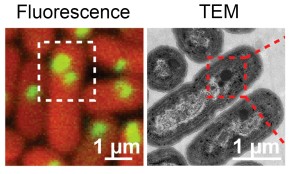A combination of time-lapse fluorescence and transmission electron microscopy reveals how cyanobacteria put together an essential component
The Science
Cyanobacteria use carboxysomes to make their own energy by “fixing” carbon from carbon dioxide from ocean waters and other aquatic and terrestrial habitats. After deleting the genes cyanobacteria need to build carboxysomes, researchers introduced fluorescent-tagged components for carboxysomes assembly. They created movies from a series of still images from a fluorescent microscope that showed carboxysomes being constructed inside live bacteria. They followed up with transmission electron images of the intermediate stages of carboxysomes assembly that revealed that carboxysomes are constructed from the inside out.
The Impact
The combination of techniques is a major advance over previous methods of visualizing bacteria as they assemble internal machinery. For the first time, researchers were able to watch cyanobacteria make their critical carbon-fixing carboxysomes. The team also suggested that other bacteria might build different types of microcompartments the same way and that their findings can be applied to designing synthetic nanoscale reactors.
Summary

A comparison between fluorescence and transmission electron microscopy (TEM) images that were converted to a “movie.” . After “turning on” the critical genes, the cyanobacteria began to construct carboxysomes out of fluorescent-tagged materials. Image credit: Jeffrey Cameron and Cheryl Kerfeld.
Cyanobacteria are one of the few bacteria that can create their own energy through photosynthesis. They “fix” carbon from carbon dioxide molecules and convert it into fuel inside of miniscule compartments called carboxysomes. Researchers reported in a paper published November 21, 2013 in the journal Cell, that bacteria build these internal compartments from the inside out. Plant, animal and other eukaryotic cells build their organelles from the outer membrane and work their way in.
Although cyanobacteria are often called blue-green algae, that name is a misnomer since algae have complex membrane-bound compartments called organelles — including chloroplasts — which carry out photosynthesis, while cyanobacteria, like all other bacteria, lack membrane-bound organelles. Much of their cellular machinery – including their DNA – floats in the cell’s cytoplasm unconstrained by membranes. However, they do have rudimentary microcompartments where some specialized tasks happen.
Icosahedral-shaped carboxysomes contain copious amounts of Ribulose 1,5 Biphosphate Carboxylase Oxygenase (commonly called RuBisCo) — an extremely abundant but slow enzyme required to fix carbon — inside their protein shells. The microcompartment also helps concentrate carbon dioxide and corral it near RuBisCo, while locking out oxygen, which otherwise tends to inhibit the chemical reactions involved in carbon-fixation.
Because they are so abundant, cyanobacteria play a major role in the earth’s carbon cycle, the movement of carbon between the air, sea and land. “A significant fraction of global carbon fixation takes place in carboxysomes,” said Cheryl Kerfeld, senior author on the paper.
Contact
Cheryl Kerfeld
ckerfeld@lbl.gov
Michigan State University and UC Berkeley (formerly of the DOE JGI)
Funding
U.S. Department of Energy, Office of Science
National Science Foundation Emerging Frontiers Program
Publication
Jeffrey C. Cameron, Steven C. Wilson, Susan L. Bernstein, Cheryl A. Kerfeld, Biogenesis of a Bacterial Organelle: The Carboxysome Assembly Pathway, Cell, Volume 155, Issue 5, 21 November 2013, Pages 1131-1140, ISSN 0092-8674,
DOI: 10.1016/j.cell.2013.10.044